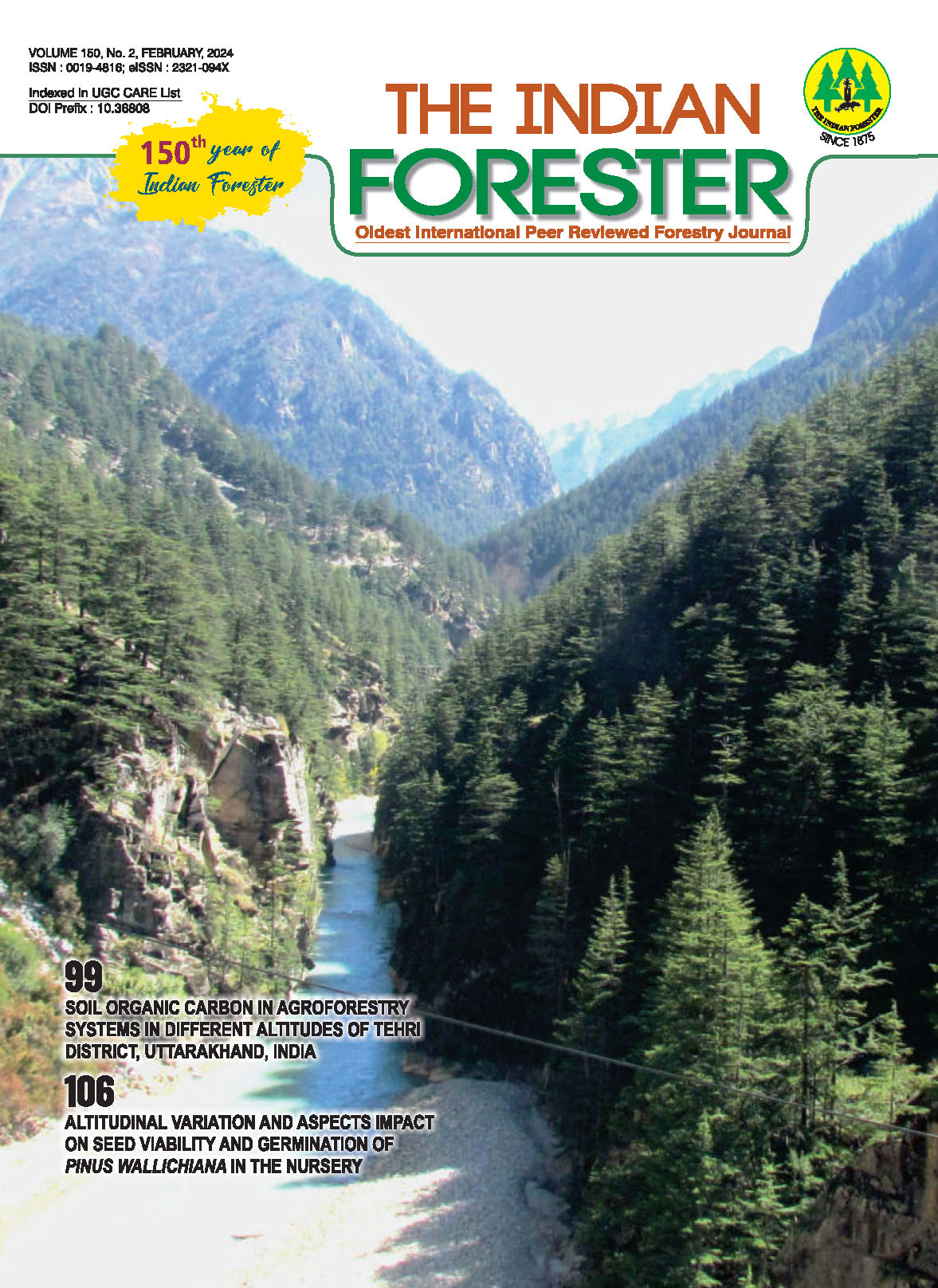Altitudinal Variation and Aspects Impact on Seed Viability and Germination of Pinus wallichiana in the Nursery
DOI:
https://doi.org/10.36808/if/2024/v150i2/169701Keywords:
Altitude, Aspect, Germination, Development, Pinus wallichiana.Abstract
The study was carried out on seed viability and germination characteristics of Pinus wallichiana seeds. Seeds were collected from four different altitudinal ranges such as, 1800-2100 (A1), 2100-2400 (A2), 2400-2700 (A3), > 2700(A4) msl and three different aspects namely, southern aspect (As1), eastern aspect (As2), and south-eastern aspect (As3) of Himachal Pradesh. The nursery was raised in the Department of Silviculture and Agroforestry forest nursery at Dr. Y.S. Parmar University of Horticulture and Forestry, Nauni in year 2020. Significant results were observed in the studied parameters; maximum seed viability was obtained at A altitude (75.5%). The 1 germination capacity (90.6%), germination percentage (84.3%), germination energy (32.7%), germination speed (3.42), and germination value (14.5) were all the highest in the southern aspect and on A (1800-2100) altitude, followed 1 by the south-eastern aspect. The correlation analysis revealed that all of the attributes had a negative correlation with altitude and regression analysis 2 showed highest adjusted R value (0.73) in germination value. According to the findings it is suggested that seeds obtained from lower altitudes were acceptable for use in large-scale planting owing to their higher vitality and overall great health.References
Bhat G.M., Mughal A.H., Malik A.R., Khan P.A., Sofi P.A., Islam M.A., Singh A. and Shazmeen Q. (2015). Altitudinal variation in different seed sources of Pinus wallichaina under the temperate conditions of Kashmir. The Ecoscan, 9: 677-681.
Bhat H.A., Mughal A.H., Mehraj U.D.D. and Mugloo J.A. (2018). Cone, seed and germination characteristics in silver fir (Abies pindrow Spach) along the altitudinal gradient in western Himalayas. International Journal of Chemical Studies, 6: 2052-2055.
Bhattacharyya A., Lamarche Jr. V.C. and Telewski F.W. (1998). Dendrochronological reconnaissance of the conifers of North-West India. Tree Ring Bulletin, 48: 21-30.
Bonner F.T. (1974). Seed testing. In: Seeds of Woody Plants in United States. Handbook No. 450. USDA Forest Service Washington D.C. pp.136-52.
Czabator W M. (1962). Germination value: An index combining speed andcompleteness of pine germination. Forest Science, 8: 386-396.
Djavanshir K. and Pourbeik H. (1976). Germination value–A new formulat. Silvae Genetica, 25: 79-83.
Farjon A. (2013). Pinus wallichiana. The IUCN Red List of Threatened Species 2013: e. T42427A2979371. doi:10.2305/IUCN.UK.2013-1.RLTS.T42427A2979371.en.
Gomez K.A. and Gomez A.A. (1984). Statistical procedure for agricultural research. 2nd edition, John Wiley and Sons, New York. 357-427p.
Koua E.L. (2003). Using self-organizing maps for information Visualization and knowledge discovery in complex geospatial datasets,Proceedings of the 21st International Cartographic Conference (ICC) Durban, South Africa, 1694-1702.
Kwan C., Xu R. and Hayness L. (2001). A new data clustering and its applications. In proceeding of SPIE-The International Society for Optical Engineering, 4384, 1-5.
Leal Saenz A., Waring K.M., Menon M., Cushman S.A., Eckert A., Renteria L.F., HernandezDiaz J.C., LopezSanchez C.A., MartÃnez-Guerrero J.H. and Wehenkel C. (2020). Morphological Differences in Pinus strobiformis Across Latitudinal and Elevational Gradients. Frontier in plant science, 11: 1-16.
Lohengrin A., Cavieres and Mary, T. K. Arroyo (2000). Seed germination response to cold stratification period and thermal regime in Phacelia secunda (Hydrophyllaceae). Plant ecology, 1-8.
Lopez T., Heredia M.H., Castellanos D.A., Garcia A.B. and Romero C.S. (2017). Reproductive investement of Pinus pseudostrobus along an altitudinal gradient in Western Mexico: implications of climate change. New Forests, 10: 1056-1060.
Mathur R.S., Sharma K.K. and Rawat M.M.S. (1984). Germination behavior of provenances of Acacia nilotica sp. Indica. Indian Forester, 110(5): 435-499.
Mosseler A., Major J.E., Simpson J.D., Daigle B., Lange K., Park Y.S., Johnsen K.H. and Rajora O.P. (2000) Indicators of population viability in red spruce, Picea rubens. I. Reproductive traits and fecundity. Canadian Journal of Botany, 78: 928–940.
Mosseler A., Rajora O.P., Major J.E. and Kim K.H. (2004). Reproductive and genetic characteristics of rare, disjunction pitch pine populations at the northern limits of its range in Canada. Conservation Genetics, 5: 571–583.
Mughal A.H. and Thapliyal R.C. (2012). Provenance variation in cone and seed characteristics of Cedrus deodara (D. DON) (G. DON) in Jammu and Kashmir. Forestry Studies in China, 14: 193-99.
Mukherjee S. (2005). Studie on provenance variation in cone, seed and seedling characteristics of Pinus roxburghii Sarg. Ph. D, Thesis, FRI Deemed University, Dehra Dun, India.
Roy M.S., Thapliyal R.C. and Phartyal S.S. (2004). Seed source variation in cone, seed and seedling characteristics across the natural distribution of Himalayan low level pine Pinus roxburghii- sarg. Silvae Genetica, 53: 116-122.
Singh M., Singh V.R.R. and Zaffar S.N. (2017). Altitudinal variation in cone and seed characteristics of Picea smithiana (WALL.) BOISS. in temperate forest of Jammu & Kashmir, India. Indian Forester, 143(7): 637-40.
Singh R.V. and Singh V. (1981). Preliminary studies on the quality of spruce and silver fir seeds as affected by its source. Indian Forester, 107(9): 571-577.
Venable D.L. (1984). Using intraespecific variation to study the ecological significance and evolution of plant life-histories. Pp 166–186. In: Dirzo, R. & Sarukhán, J. (eds) Perspectives on Plant Population Ecology. Sinauer, Sunderland.
Downloads
Downloads
Additional Files
Published
How to Cite
Issue
Section
License
Unless otherwise stated, copyright or similar rights in all materials presented on the site, including graphical images, are owned by Indian Forester.





